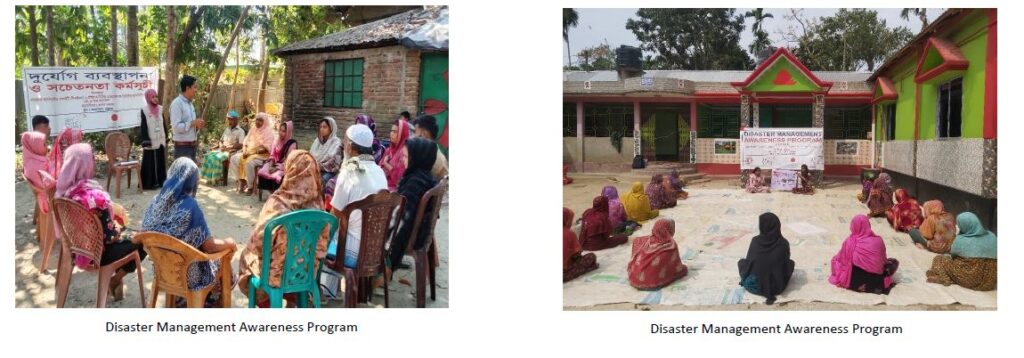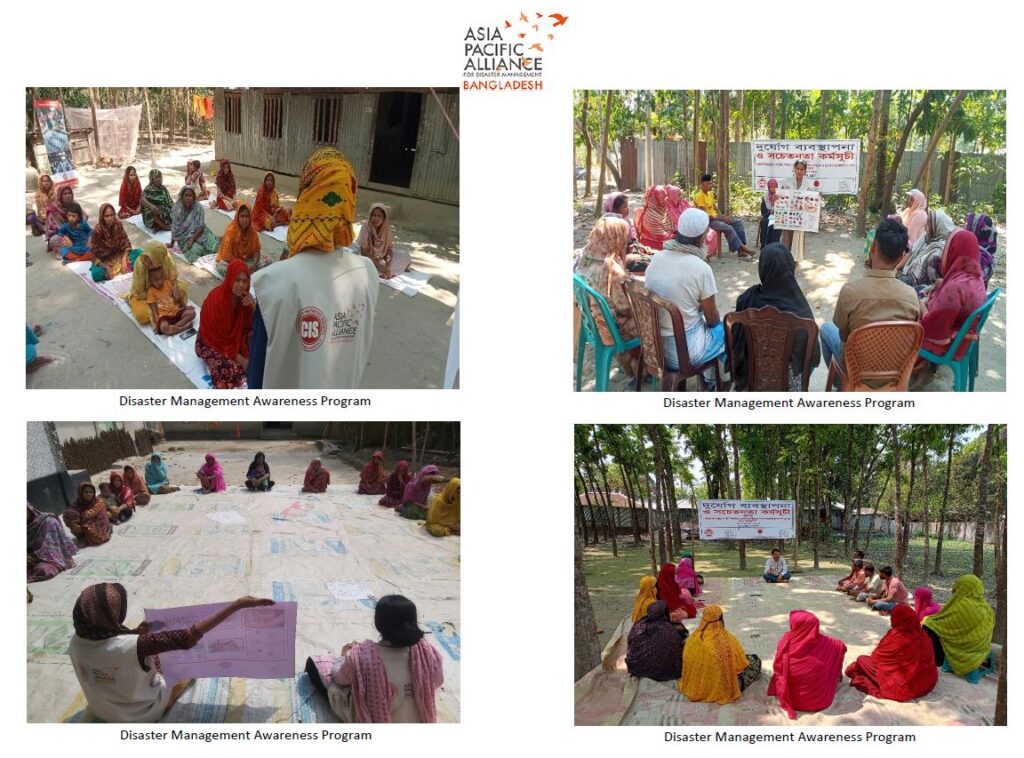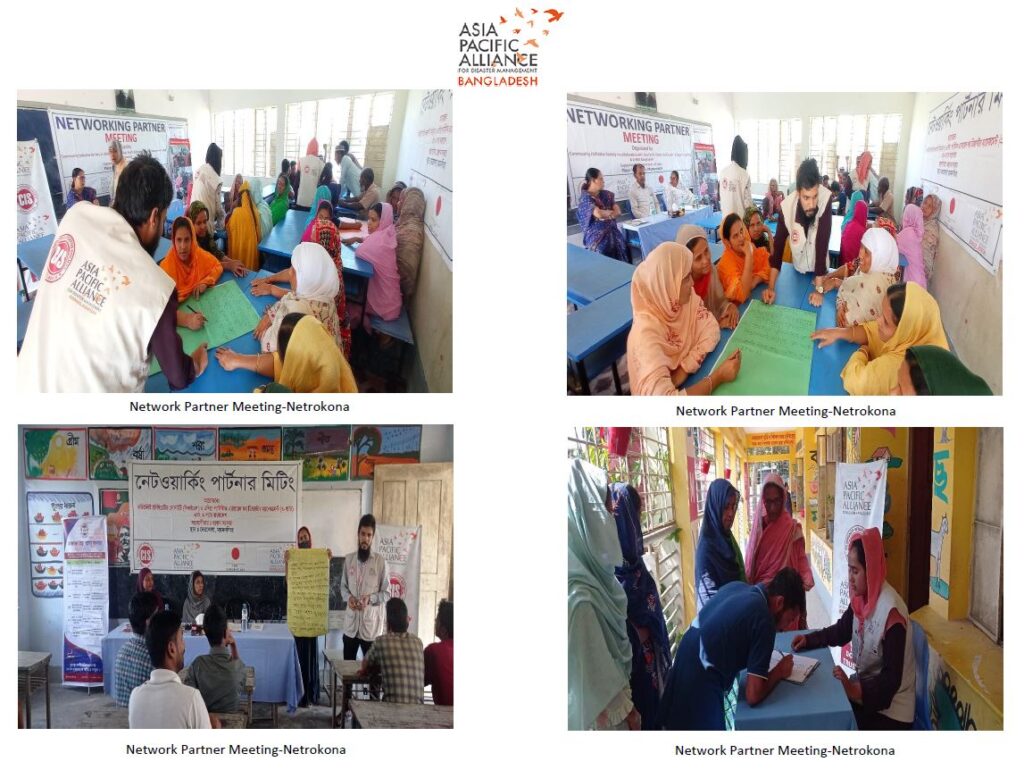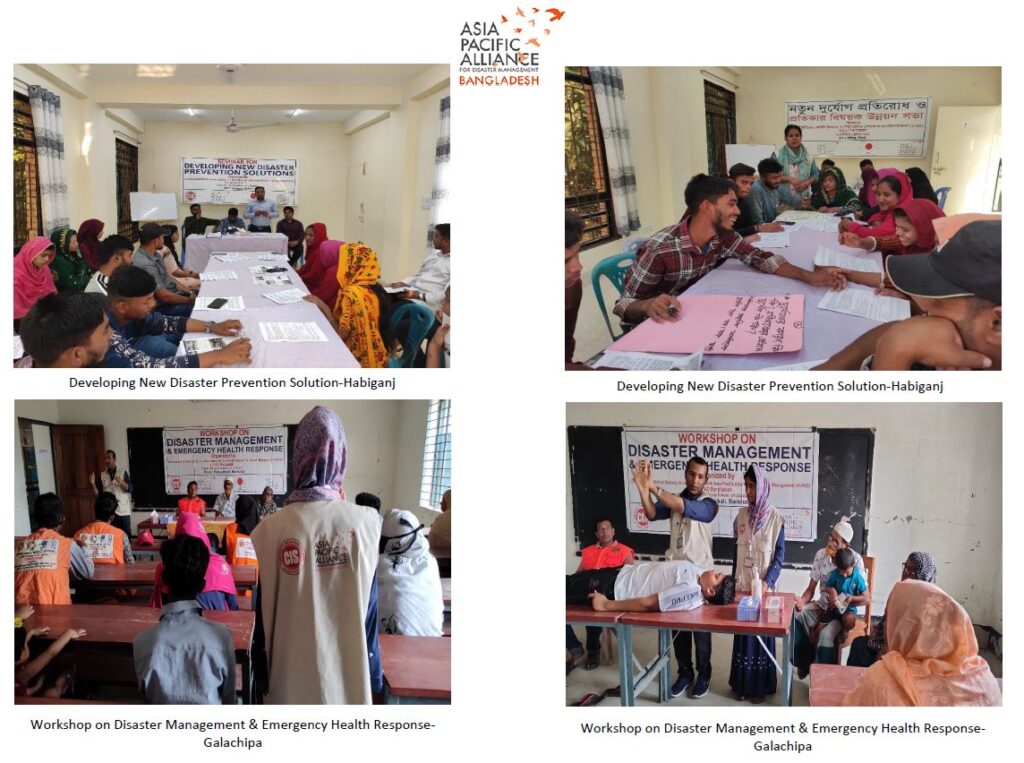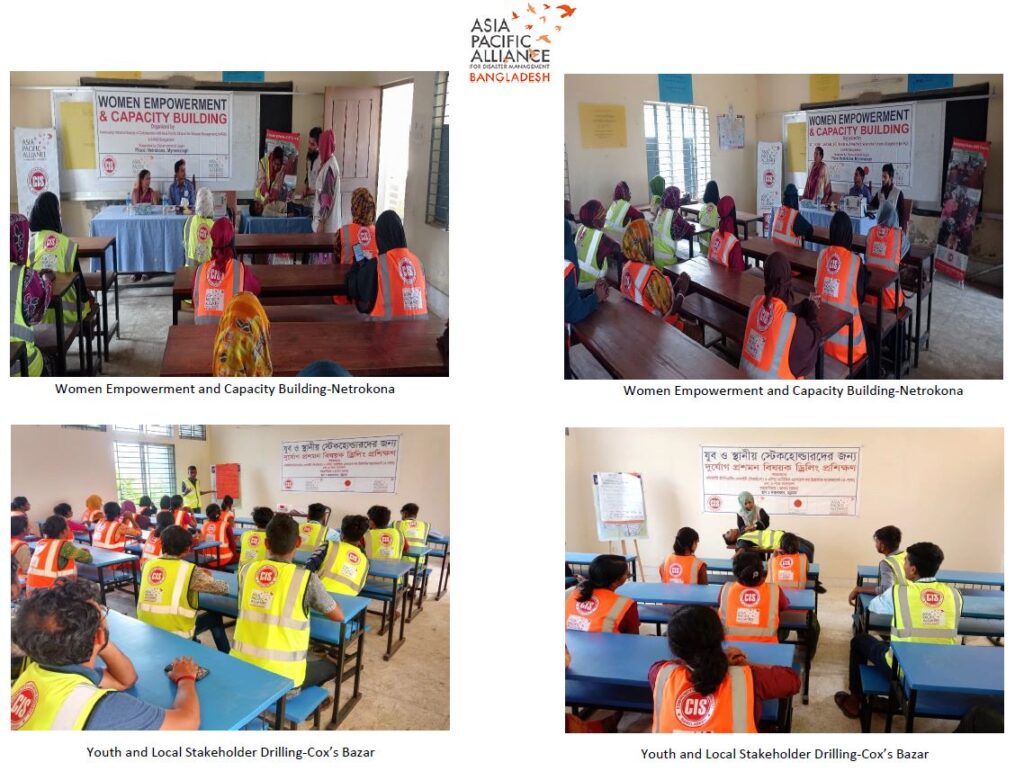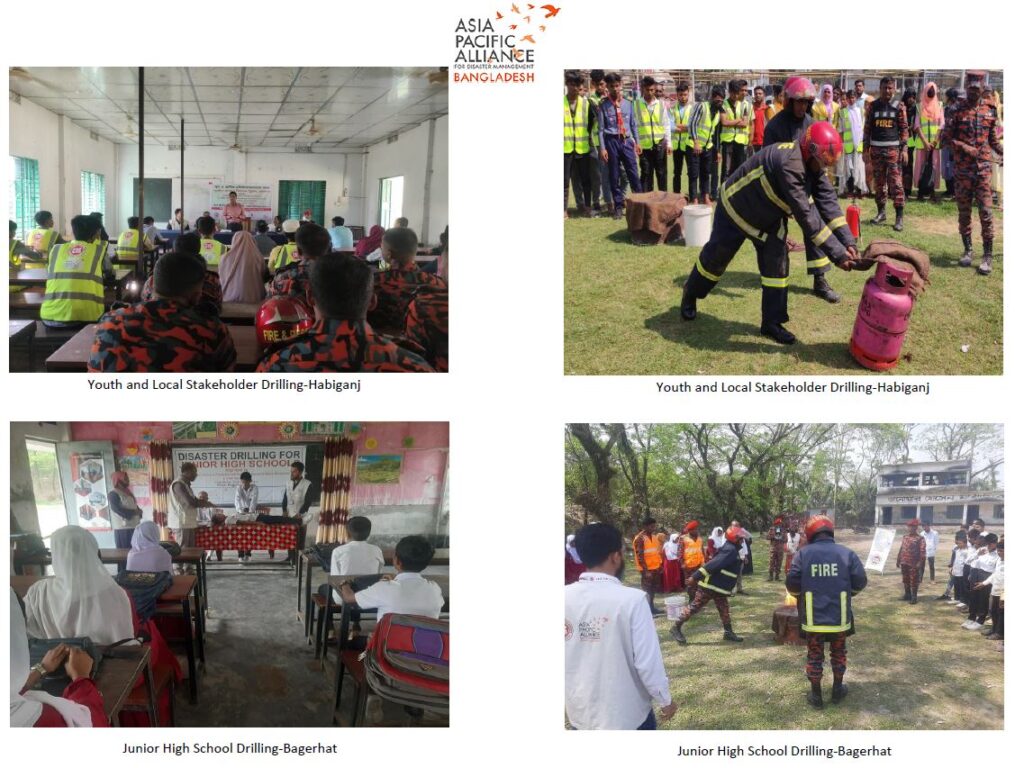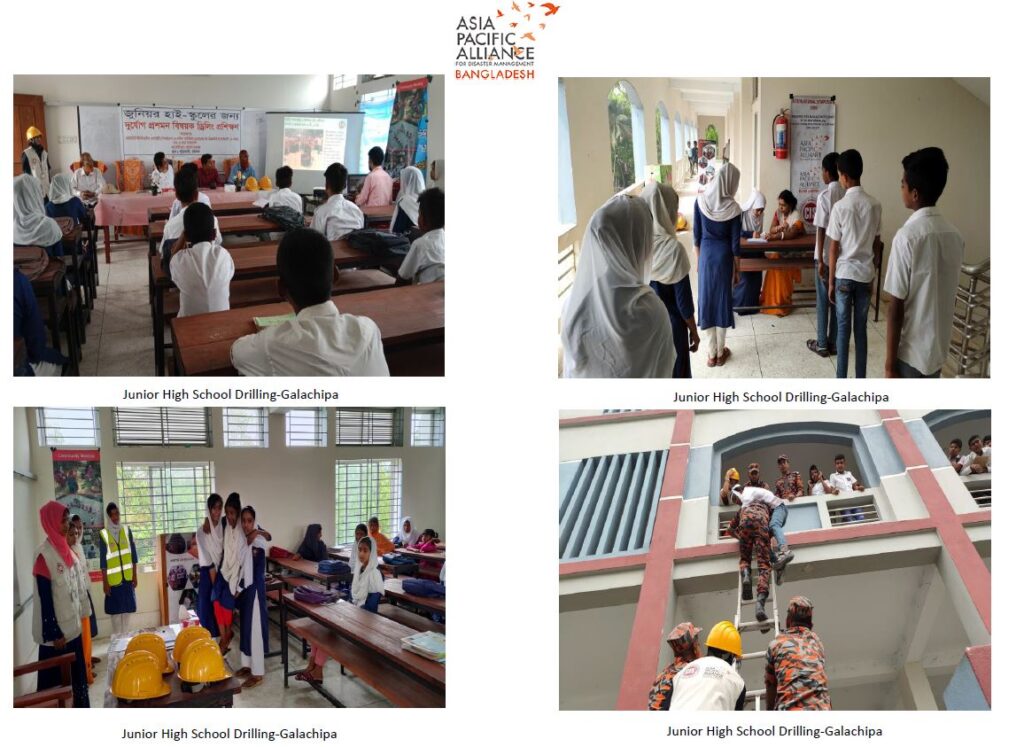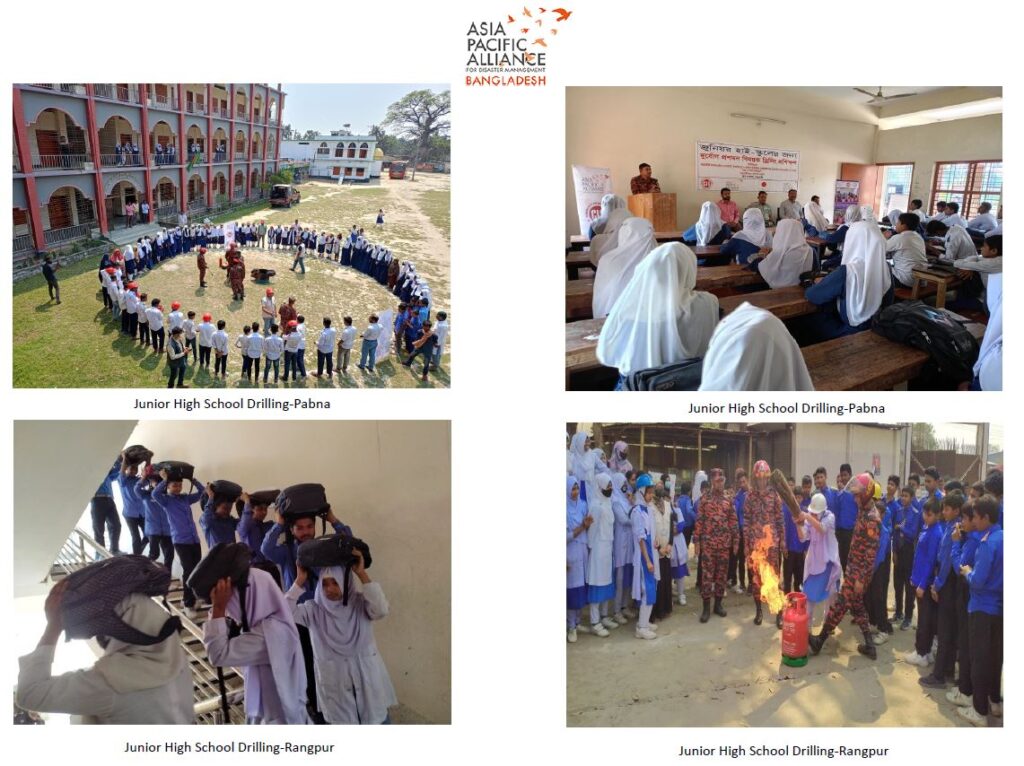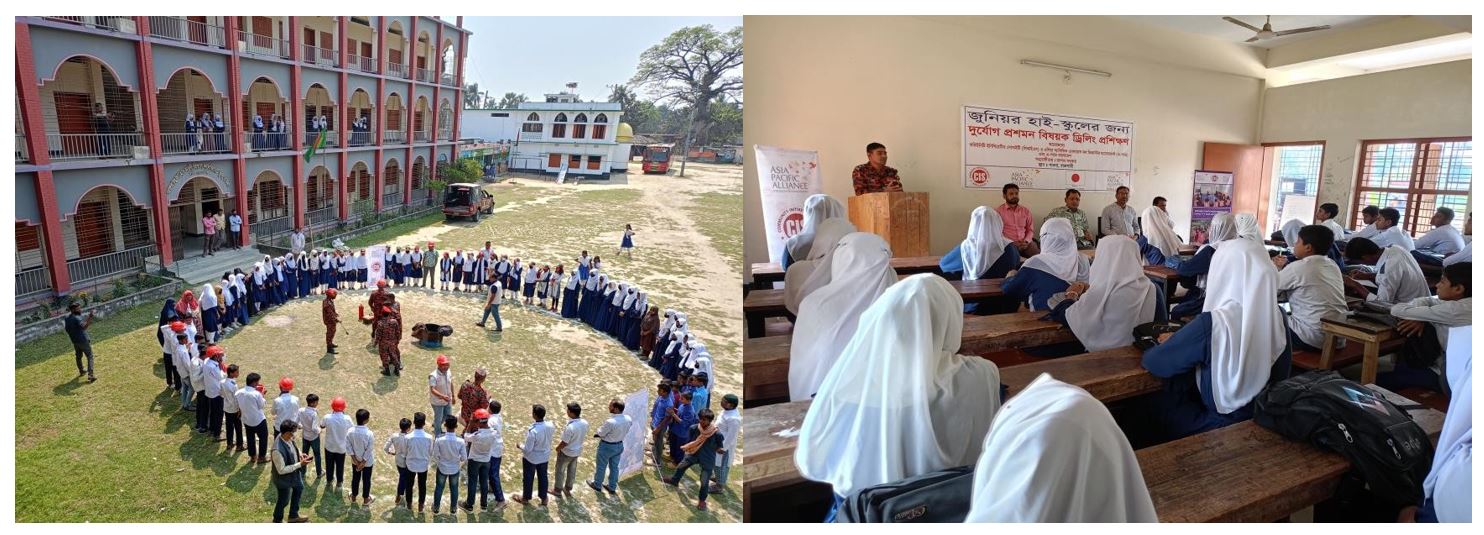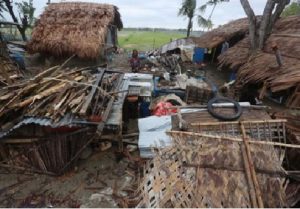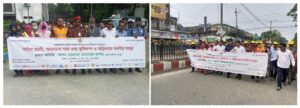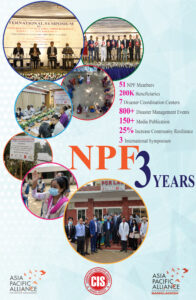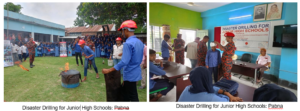Project Title: Strengthening Capacity for Sustainable Disaster Management Network by involving multi-sectoral platform Project Period: 17 January, 2024– 16 January, 2025 (12 month)
- Project Activities and Accomplishments
Bangladesh is ranking as one of the most disaster-prone countries. People in Bangladesh are often affected by water-related natural disasters, including floods, riverbank erosion and cyclones. In addition, recent rapid urbanization increases the risks for earthquake as well as man-made disasters. National Plan for Disaster Management (NPDM) 2021-2025 exemplified the strategic plan of the Government of Bangladesh in its Vision and the Mission of the Ministry of Disaster Management and Relief (MoDMR) between 2021 and 2025 towards building resilient nation. Bangladesh GOVT. has NPDM 2021-2025 has core goals for actions to save life, reduce economic losses in every disaster cycle stages which includes Disaster Risk Reduction (DRR), Humanitarian Response and Emergency Recovery Management. In Bangladesh most hazards impact: flood; cyclone and surge; tornado; earthquake; riverbank erosion; landslide; salinity intrusion; drought; tsunami; lightning; arsenic contamination; human-induced hazards and health hazards. The last hazard has potential for assuming significance because of the emerging risks in Bangladesh.
A-PAD Bangladesh started project from January 2023 and presently continue it 17 January 2024 to build up capacity on disaster management. It communicates with the different sectors like local community, community leaders, stakeholders, GOVT. officials continuing training on disaster management. To hold training program A-PAD Bangladesh staff organized small community meeting to sharing ideas on disaster and introduced them about A-PAD Bangladesh activity. A-PAD Bangladesh working 8 divisional areas.
There are 1 health workers in each divisions whose are doing home visit and aware the local community about basic disaster awareness. The health workers gave basic ideas about disaster management. A-PAD Bangladesh working at the rural areas. If there would be any directions or announcement from GOVT. or any disaster related news has been published the health workers delivered the message to the local community. Total 3,909 persons were benefited from A-PAD Bangladesh on March 2024.
A-PAD Bangladesh attended coordination meeting at the 8 divisions in Office of Deputy Commissioner. At that meeting different NGOs had joined and explained their activities. Besides this what will be the next activities of the GOVT. and NGOs were discussed at that meeting.
1. Strengthening of disaster risk reduction and disaster response system functions through the Emergency Disaster Management Coordination Center | ||
Activities | ( Outcome 1 ) The Emergency Disaster Management Coordination Center operated under this project will function as a disaster response base in each region, leading to the disaster risk reduction in the community and the strengthening of its disaster response system.: | Project Status: Achievements vs Outcome: If the activity is behind the schedule, please write the reason. |
1-1 Operation of Emergency Disaster Management Coordination Centers Target:Local communities 10 people×25 days×8 divisions×12 months =24,000 people | 【Indicators of Outcome】 1-1 The Emergency Disaster Management Coordination Center will be used for coordination meetings among partner organizations and relevant stakeholders during normal times, and will also serve as a center for health and public health guidance for the local residents. In the time of emergency, health services will be provided by emergency health workers. The Emergency Disaster Management Coordination Center will be used by 24,000 local residents (annual average) in the target area. (Indicator:number or visitors, record of services provided) 1-2 Through the Disaster Management Awareness Program, community residents will receive the latest disaster information and knowledge on how to respond to disasters, and people’s awareness of disaster prevention and response will be increased. (Indicator:Community disaster preparedness report) | Total 2652 people visited to the Disaster Management Coordination Center to discuss about disaster preparedness and health related issues. Dhaka: 320 Persons Cox’s Bazar: 335 Persons Pabna: 316 Persons Bagerhat: 366 Persons Patuakhali: 342 Persons Habiganj: 323 Persons Rangpur: 335 Persons Netrokona: 315 Persons Total = 2,652 Persons |
1-2 Disaster Management Awareness Program Target:Local communities, Community leaders, Local NGOs, Private company workers, government officials 15 people × 8 divisions × 4 times ×12 months =5,760 people | A-PAD Bangladesh conducted Disaster Management Awareness programs at the 8 divisional areas where 497 persons have participated. Total 4 times training organized at each divisional areas. Dhaka:15 Participantsx 4 Sessons= 60+3=63 Participants Cox’s Bazar: 15 Participantsx 4 Sessons= 60+5=65 Participants Pabna: 15 Participantsx 4 Sessons= 60+1=61 Participants Bagerhat: 15 Participantsx 4 Sessons= 60+2=62 Participants Patuakhali: 15 Participantsx 4 Sessons= 60 Participants | |
|
| Habiganj: 15 Participantsx 4 Sessons= 60=62 Participants Rangpur: 15 Participantsx 4 Sessons= 60+2=62 Participants Netrokona: 15 Participants x 4 Sessons= 60+2=62 Participants |
2. Expansion of disaster management network to improve community vulnerability | ||
| (Outcome 2)The network of NPF will be expanded and the capacity of each region for disaster prevention and response will be strengthened. |
|
2-1 Network Partner Meeting Target : Local communities, Community leaders, Local NGO, Private Company Workers, Government officials 50 people × 5 villages × 8 divisions = 2,000 people | 【Indicator of Outcome】 2-1 Strategies, mechanisms, and action plans for disaster reduction cooperation are developed in each region through discussions at network partner meetings, and a framework for disaster reduction cooperation is established. (Indicator:Strategic Plan) 2-2 MOUs signed with at least 5 new organizations, including private companies, in A-PAD Bangladesh NPF to expand the network (Indicator:number of new MOUs signed) 2-4 Resources possessed by A-PAD BGD partner organizations are provided in emergency disaster response, and play the role of that organization in times of emergency. (Indicator:List of resources such as supplies, human resources and donations provided by partner | A-PAD Bangladesh organized 5 days Network partner Meeting at 5 villages in Netrokona. Total 263 participants has joined the meeting. 03 March 2024-Bikramsri: Total Participant- 50+2=52 Participants 05 March 2024-Lauful: Total Participant- 50+5=55 Participants 06 March 2024-Bori: Total Participant- 50+2= 52 Participants 07 March 2024-Godayun: Total Participant- 50+1= 51 Participants 09 March 2024- Islampur: Total Participant- 50+3=53 Participants On first day of the meeting, Md, Nizan Uddin, UP Member of Barhatta, emphasized on the flood situation in Netrokona has deteriorated due to torrential rain and the onrush of water from upstream. On the other hand the water level of the Surma river has decreased due to reduced rainfall in Sunamgonj. He mentioned that having an evacuation plan in place before a flood occurs can help avoid confusion and prevent injuries and property damage. A thorough evacuation plan should include: |
| organizations for emergency disaster response) | Ø Conditions that will activate the plan Ø Chain of command Ø Emergency functions and who will perform them Ø Specific evacuation procedures, including routes and exits Ø Procedures for accounting for personnel, customers and visitors Ø Equipment for personnel Review the plan with workers On the second day Md. Afroza Akter, Volunteer Team Leader shared that Disaster is arguably one of the most important factors preventing many Bangladeshi children from enjoying their right to education. While the country made significant progress in establishing effective policies, institutions and practices in disaster risk management, it remains too fragile with its primary education. Limited knowledge about the DRR in education is one of the primary reasons for not being able to attract adequate attentions required. On the third day there was discussion on climate change. Bangladesh continues to face severe and increasing climate risks. Without urgent action, including further adaptation and resilience measures, the country’s strong growth potential could be in risk. Actions focused on improved agriculture productivity, energy and transport efficiency can lower future emissions while improving air, soil, and water quality. Climate change will hit poor and vulnerable people the hardest. On the fourth day Humayun Kabir, UP member was present there and shared Mymensingh divisions existing |
|
| disaster management policy and shared that we ne CBDMP- Commiunity based disaster management plan for sustainable disaster management.on the fourth and fifty day there was brief discussion on National Plan for Disaster Management (2021-2025) is upgraded from the previous National Plan for Disaster Management (NPDM) 2016- 2020 as well as 2010-2015, which were the first policy document of its kind. |
2-2 Disaster Preparedness Campaigns Target:Partner organizations and local communities 50 people × 2 times × 8 divisions = 800 people |
| |
2-3 Network Partners Capacity Strengthening (DRR) Target : Partner organizations 20 people × 2 organizations × 2 times × 8 divisions = 640 people | A-PAD Bangladesh Organized Network Partner Capacity Strengthening DRR at 2 divisional areas in Cox’s Bazar and Dhaka. 06-07 March 2024, Dhaka, Total Participants 40+2= 42 Participants 10-11 March 2024, Cox’s Bazar, Total Participants 40+1= 41 Participants A massive fire that raged through a six-storey building home to restaurants where many families with children were dining has killed at least 46 people and injured dozens. Fire authorities said a gas leak or a stove could have caused this blaze in the capital, which spread quickly after breaking |
|
| out in a biryani restaurant, and was only brought under control following two hours of effort by 13 units of firefighters. Fire Safety Training One of the most important aspects of restaurant fire safety is ensuring establishment has thorough fire safety training. Employees should be instructed on fire safety protocols, learning steps they can take to prevent fires and the common fire hazards to avoid. Additionally, it is critical that employees are well-trained in fire response, allowing them to react to fires safely. To develop a thorough fire safety course, include the following in your establishment’s training: 1. Fire Safety Equipment – All staff should know how to handle and use fire safety equipment and emergency supplies such as fire extinguishers. 2. Power Sources – Kitchen staff should be aware of various power source locations and how to turn them off to prevent fueling a fire. 3. Crisis Response – Train employees on how to respond calmly to emergencies such as fires, preventing panic and fear. 4. Types of Fires – Instruct staff on the different types of fires that can occur in the kitchen, and how to respond to them. |
|
| 5. Chemical Safety – Teach employees how to safely handle dangerous chemicals and other flammable objects. 6. Refresher Courses – Provide employees with frequent fire safety refresher courses to ensure information stays fresh in their minds.
Cox’s Bazar is one of the districts of Bangladesh already vulnerable to many gradual changes. Many Disasters happen every Year in Cox’s Bazar. Specially Cyclones and landslides are one of them. To prevent Cyclone and landslides CIS works beside the government sector. CIS conducted a 2 days training program on Networking Partners Capacity Strengthening (DRR) in Cox’s Bazar. In this training program 2 local Ngo Participated. A total of 41 participants joined that training workshop. The training was conducted for Two days focusing on different topics. The main focus of the training was Strengthening Disaster Risk Reduction.
On 1st Day, the Chief Executive Officer of ORNAB Cox’s Bazar Md. Nurul Azim discussed Effective disaster mitigation measures are vital to a lifeline for coastal communities and potentially affected people in Bangladesh. The increased population density in the coastal areas has made the coast more vulnerable for |
|
| disaster and for sustainable development of coastal |
infrastructures. | ||
On 2nd Day, Program Officer of Sujula Mohila Samite Cox’s | ||
Bazar, Kamal Uddin focused on Fire extremes in | ||
Bangladesh, He also said that Fire accident is very | ||
dangerous and powerful disaster. Fire is difficult to deal | ||
with if you have no pre-preparation. He mentioned the fire | ||
that happened in Dhaka bailey road. He mentioned Cox’s | ||
Bazar is prone a cyclone prone area it almost happened | ||
during the early summer (April to June) and the late rainy | ||
season (September to November), and better preparedness | ||
efforts at the local level by improving partners | ||
understanding of vulnerabilities, threats and capabilities. | ||
2-4 Seminar for Developing New Disaster Prevention Solutions Target : NGO, Disaster prevention related government organizations, Private sector personnels 30 people ( 2days ) × 8 divisions × 2 times = 480 people |
2 days seminar has been organized in Habiganj, Dhaka and Bagerhat. Total 100 participants from 3 divisional areas had joined the seminar. 24-25 March 2024, Bagerhat, Total participants 30+3=33 Participants 27-28 March 2024, Dhaka, Total participants 30+2=32 Participants 27-28 March 2024, Habiganj, Total Participants 30+5=35 Participants | |
| Bagerhat district is one of the disaster-prone areas in | |
| Bangladesh. On 24,25 March Community Initiative Society |
|
| (CIS) organized a training workshop on Seminar for Developing New Disaster Prevention Solutions in Sharankhola, Bagerhat. The Disaster Prevention Solutions Seminar in Bagerhat addressed the region’s specific challenges, including floods, lightning, riverbank erosions, and other natural disasters. It focused on topics such as early warning systems, community-based disaster preparedness, and infrastructure development. The seminar aimed to bring together experts, researchers, policymakers, and practitioners in the field of disaster prevention and management. In recent years, Habiganj, a district located in the northeastern region of Bangladesh, has faced significant challenges posed by natural disasters. The area is prone to various calamities such as floods, lightning, and riverbank erosions, which often result in loss of lives, damage to property, and disruption of livelihoods. These disasters not only impact the immediate well-being of the inhabitants but also hinder the overall socio-economic development of the region. 1. Foster Innovation: The seminar aimed to foster innovation in disaster prevention by encouraging participants to think creatively and outside the box. It sought to inspire new ideas and approaches to address |
|
| the unique challenges faced by Dhaka in mitigating the adverse effects of natural disasters. 2. Knowledge Sharing: The seminar provided a platform for key stakeholders, including representatives from various disaster management NGOs, government officials, researchers, and community leaders, to share their knowledge, experiences, and best practices in disaster prevention and management. 3. Collaboration: By bringing together diverse expertise and experiences, the seminar aimed to facilitate collaboration among stakeholders. It encouraged networking and partnerships to enhance collective efforts in developing effective disaster prevention solutions tailored to the needs of Dhaka. 4. Context-Specific Solutions: Recognizing the importance of context-specific solutions, the seminar aimed to leverage local knowledge, resources, and expertise to develop disaster prevention strategies that are tailored to the needs and realities of the Dhaka community. 5. Addressing Multiple Challenges: The seminar covered a wide range of topics related to disaster risk reduction, early warning systems, infrastructure resilience, community-based preparedness, and sustainable development strategies. It aimed to address multiple |
|
| challenges faced by Dhaka in terms of disaster prevention comprehensively. 6. Long-Term Impact: Ultimately, the seminar aimed to contribute to the long-term safety, well-being, and resilience of the people of Dhaka by generating ideas and initiatives that could inform future disaster prevention efforts and contribute to sustainable development in the region. |
2-5 International Symposium on DRR Target : Government, Local government, private company, NOG, partner organization, representative of A-PAD member countries, etc. 200 people |
| |
3. Practical training to improve resilience of local communities | ||
| ( Outcome 3 ) Contribute to improving the disaster resilience of local communities through practical training. |
|
3-1 Disaster response capacity building of local community level in Health and | 【Indicator of Outcome】 3-1 a) Establish networks of community leaders who can lead disaster response and |
|
hygiene field | emergency health response in all districts of Bangladesh. (Indicator:Number and the List of community leaders for disaster response/emergency health in each 8 districts.) b) Networks of human resources with the skills and know-how to respond to health emergencies will be established in all districts of Bangladesh to provide health services to the local residents in times of emergency. (Indicator:Data of NGO health personals who can respond in emergency. Number of residents who received the services in the cases of activities during emergency disaster in each 8 districts.) 3-2 a) Disaster preparedness training and drills will be documented in a manual, and women, youth groups, and local stakeholders who participate in the drills will be granted certificates of completion and work as disaster volunteer teams during actual disasters. (Indicator:Drilling Manual, Cases of activities in emergency disaster response)
b) Disaster drills at junior high schools will be |
|
3-1 a) Workshop on Disaster Management and Emergency Health Response Target : Local residents, Community leaders, Local NGO workers 25 people ( 2 days ) × 8 divisions × 2 times = 400 people | A-PAD Bangladesh conducted 2 days workshop at Bagerhat, total 25 participants joined the training workshop. 10-11 February 2024, Bagerhat, Total 25 participants | |
3-1 b) Training of Local Health Workers on Disaster Health Activities Target : Health workers who belong to local NGOs or civil organizations 20 people ( 3 days ) × 8 divisions = 160 people |
| |
3-2 Strengthening disaster response capacities of local communities through disaster drilling training |
| |
3-2 a) Women Empowerment and | Two days drilling program organized in 2 divisional areas where 47 women has been joined the drilling program. |
Capacity Building Target : Women’s groups in target villages 20 people ( 2 days ) × 8 divisions × 2 times = 320 people | documented in a manual so that students who participate in the drills will have the skills to take appropriate action in the event of a disaster. (Indicator:Drilling Manual, Report of emergency disaster response) | 20-21 March 2024, Habiganj, Total Participants 20+2=22 Participants 27-28 March 2024, Netrokona, Total Participants 20+5=25 Participants On March 20,21- 2024, the Community Initiative Society (CIS) in Habiganj organized a Woman Empowerment & Capacity Building Training event, focusing on disaster awareness for women from the local community. The training aimed to equip participants with essential knowledge and skills related to disaster preparedness, response strategies, evacuation procedures, and risk mitigation during emergencies. By emphasizing disaster awareness, CIS sought to empower women to protect themselves, their families, and their communities effectively during crises. 1. Empowerment: To empower women by providing them with essential knowledge and skills necessary to effectively respond to disasters and emergencies. 2. Capacity Building: To build the capacity of women in the local community to take proactive measures in disaster preparedness, response, and risk mitigation. |
|
| 3. Knowledge Enhancement: To enhance participants’ understanding of disaster situations prevalent in Habiganj and equip them with the necessary information to navigate such scenarios confidently. 4. Skill Development: To equip participants with practical skills such as first aid training, fire accident drilling, and evacuation procedures, enabling them to respond effectively in emergency situations. 5. Community Resilience: To contribute to the overall resilience of the community by empowering women as key agents in disaster preparedness and response efforts.
Although Bangladesh has become a role model for its climate change adaptation model, for women, the lack of access to assets such as land and money, restricted access to information, policy-making processes and necessary social networks, translate to more suffering. Women empowerment and leadership in DRR will be enhanced participatory and inclusive disaster risk management will be developed by involving women in DRR. |
|
| CIS Conducted a 2 days training program in Mymensingh on |
Women Empowerment and Capacity Building. This | ||
program aims to equip women with practical skills and | ||
knowledge that help them lead gender-inclusive and | ||
community-based disaster risk reduction management. | ||
Women should be trained and motivated through creating | ||
proper environment and opportunity to take up challenging | ||
task equally. On this 2 days training program CIS gave a brief | ||
on disaster and emergency situations necessary steps they | ||
also demonstrated how one can give primary treatment in | ||
the time of emergency. | ||
3-2 b) Disaster Drilling for the Youth and Local Stakeholders Target:Youth in the local private and civic sector 45 people ( 2 days ) × 8 divisions × 2 times = 720 people | Youth and local stakeholder drilling program organized in Habiganj and Cox’s Bazar where 95 participants joined. 05-06 March 2024, Habiganj, Total Participants 45+2=47 Participants 19-20 march 2024, Cox’s Bazar, Total Participants 45+3=48
To improve resilience, the country has implemented multispectral and muti-level national interventions based | |
| on international guidelines over the past few years. As a | |
| result, local people have become more knowledgeable | |
| about and adept at coping with disasters. Youth can be | |
| recognized as resources and competent citizens in their | |
| own right, rather than as problematic or passive recipients | |
| of services. In adult-dominated processes, tokenistic | |
| treatment of a few youth members fails to recognize youth |
|
| as assets with meaningful contributions to offer. The youth’s role in tackling climate natural disasters is irrevocably present; volunteerism is one of the major aspects that pertain to the youth. Climate-related disasters are beginning to overwhelm adaptation efforts in Bangladesh’s coastal region. The country has gone to great lengths to adapt and limit the possibility of calamity. Over the last few decades, its Cyclone Preparedness Programme, has drastically reduced disaster mortality. Disaster preparatory organizations have realized this and put emphasis on capacitating the youth in recognizing and assessing early incoming disasters, these training modalities try and empower them as agents of change and advocate better climate disaster preparedness, as it is then these youths that capacitate their local community in understanding early warning systems and what to do during disasters. The Disaster Drilling Program for Youth and Stakeholders recognizes the diversity of its participants, ranging from youth and parents to educators, emergency responders, healthcare professionals, and community leaders. It acknowledges the strength inherent in this diversity, promoting a holistic approach to disaster preparedness that ensures knowledge, skills, and responsibilities are shared across the community. |
3-2 c) Disaster Drilling for Junior High Schools Target:School Children 40 people ( 2 days ) × 8 divisions × 2 times = 640 people |
| Disaster Drilling for Junior High School conducted in 3 Divisional areas. Total 172 participants joined the drilling program. 11-12 March 2024, Rangpur, Total Participants 40+2=42 Participants 12-13 March 2024, Pabna, Total Participants 40+3=43 Participants 13-14 March 2024, Bagerhat, Total Participants 40+4=44 Participants 18-19 March 2024, Galachipa, Total Participants 40+3=43 Participants The main focus on training workshop was on build up on capacity on emergency response during and after disaster. The program started with registration by the school students. It addressed the gathering and spoke on the importance of disaster drilling. It was highlighted that the skills learnt in the program will help the students to use them in their daily lives to save the lives of others in emergencies. First-day sessions included Fire, Earthquake, Rescue management, lifting activity, and live experience of handling disaster victims. On the second day, the sessions were held on bandages, fracture management and Demonstration Practical. In the end, students were divided into groups, one group acted as victims, and one group as rescue team. Student feedback was collected and students expressed their gratitude towards the resource person and |
|
| organizers for arranging live sessions and making the event fruitful. The drill was carried out systematically, with the ringing of the fire alarm and announcement by the respective Vice Principal, Headmistress and Supervisor. The students were evacuated to their designated open assembly point as per the colour-coded evacuation plan. After the exercise, they went back to their classes and were again briefed about the route they needed to follow in case of such an emergency. In the training Program the teachers and facilator from Bangladesh Fire service shared their opinion that involving juniors in disaster activities need to increase as if we educate our children on DRR our next generation will be capable enough to build a safer world. We all know childhood education is the base of one life so disaster education for children plays an important role in human life. |
3-3 Update website contents as E-resources for Disaster Management | https://apad-bd.org/a-pad-bangladesh-activity-report- month-of-february-2024/ https://apad-bd.org/print-media/ https://apad-bd.org/wp-content/uploads/2024/04/1.jpg https://apad-bd.org/wp-content/uploads/2024/04/2.jpg https://apad-bd.org/wp-content/uploads/2024/04/3.jpg |
- Challenges
Please write Challenges and its impact upon the project implementation. (Ex. lockdown, Political situation, Curfew)
- Practice in collaboration with A-PAD Bangladesh Network Partners Please write good practice in collaboration with partner organizations
- Any contribution Funds Received and Grants Applied / Planned and Implemented Projects by CIS including Emergency Response
Please write Projects name and its fund resources
- Relationship with Bangladesh Government and Japanese Embassy
Please write about Meeting with Government officials
